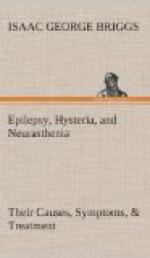The fact that recovery is rare should not be hidden from patients and friends. Perhaps 8 per cent of all classes recover—and “recovery” may only be a long interval—but 4 per cent of these are Jacksonian, syphilitic or accident cases. Only one victim in every thirty recovers from true epilepsy; and these are very mild cases, in which the fits are infrequent, there is no mental impairment, and bromides are well borne. The earlier the onset, the more severe and frequent the attacks, the deeper the coma, and the worse the mental decay, the poorer the outlook.
Cure is exceptional, but by vigorous treatment the severity of the malady may be much abated. Petit mal is no more hopeful than grand mal; less so in cases with severe giddiness; in all cases, the better the physical condition and digestive powers of the patient, the brighter the outlook.
To sum up, epilepsy is a chronic abnormality of the higher nervous system, characterized by periodic attacks of alteration of consciousness, often accompanied by spasms of varying violence, affecting primarily the brain and secondarily the body, based on an abnormal readiness for action of the motor cells, occurring in persons with congenital nerve weakness, and leading to mental decay of various types and degrees of severity.
* * * * *
CHAPTER IV
CAUSES OF EPILEPSY
“Find out the cause of this effect,
Or rather say, the cause of this defect,
For this effect defective comes by cause.”
“Hamlet,” Act II.
THE MECHANISM OF THE FIT
The brain consists of cells of grey matter, grouped together to form centres for thought, action or sensation, and white matter, consisting of nerve strands, which act as lines of communication between different parts of brain and body. The wrinkled surface (cortex) of the brain, is covered with grey matter, which dips into the fissures. There are also islands of grey matter embedded in the white.
The front part of the brain is supposed, with some probability, to be the seat of intelligence, while a ribbon three inches wide stretched over the head from ear to ear would roughly cover the Rolandic area, in which are contained the motor cells through which impulse is translated to action. These motor cells are controlled by inhibitory cells, which act as brakes and release nerve energy in a gentle stream; otherwise our movements would be convulsive in their violence, and life would be impossible through inability usefully to direct our energy.
That is how inhibition acts physically; mentally it is the power to restrain impulses until reason has suggested the wisest course.




